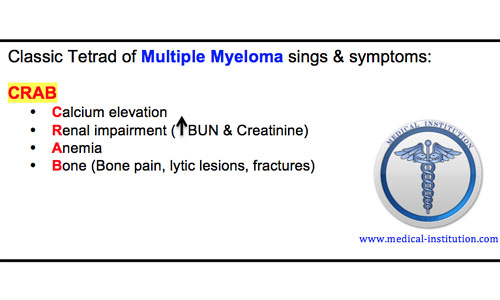Difference between myeloma and multiple myeloma
The word Myeloma takes origin from two parts, namely “myel” which means from the marrow and “oma” meaning tumor. The word is derived from the Greek term Myeloma which later on was called as Multiple Myeloma as the tumor usually spreads out to distant places in the body.
Etiology:
The exact cause for the tumor is not known but it is a life-threatening malignant process in the body. A Myeloma is a tumor of the plasma cells present in the blood. Plasma cells are formed from white blood cells called as B lymphocytes. These are mature cells and their main function is to fight infections invading in the body. In multiple myeloma, there is an abnormally large number of these plasma cells being produced.
Patho-physiology:
There is large accumulation of myeloma cells being formed in the bone marrow. These myeloma cells form huge clusters of cells and circulate and settle in various tissues in the body while many of these clusters are formed in the bone marrow itself. It eventually causes disruption in the formation of other cells in the bone marrow like RBC, WBC and platelets. This leads to overall decreased counts of all the other vital cells of blood. Over time, the patients become anemic due to the low red blood counts and develop tendency to get infections due to low white blood counts.
These tumor cells also secrete chemicals which lead to calcium breakdown from the bones and thus, patients tend to report sudden and severe bone pains. Bones become weak and brittle and prone to repetitive fractures.
Myeloma cells produce a special protein called as protein M which circulated in large quantities in blood and urine. This protein can cause damage to the kidney.
Symptoms:
Anemia is common due to lack of red cells which causes tiredness, weakness and shortness of breath.
Increased and unexplained bleeding or bruising of skin due to a low platelet count is a common feature of multiple myeloma.
There is calcium reabsorption from various bones; thus, the bones become brittle and prone to fractures. Patients often report fractures without any history of injury or fall.
To diagnose myeloma one can perform blood and urine tests and look for Bence Jones’s protein which is a hallmark diagnostic feature of multiple myeloma.
Treatment:
There are two parts of the treatment. One is to control the myeloma symptoms i.e. supportive therapy and the other one is to prevent remission as that is very common. Corticosteroids along with interferons are used to prevent remission of disease. Nutritional supplements and blood cell transfusions are done to replenish the deficiencies of red, white blood cells and platelets.
Summary:
There is no difference in the terms myeloma and multiple myeloma. They are mere representations of the same condition with updated terminology. Myeloma or multiple myeloma is a malignant cancer of the plasma cells produce in the bone marrow. This leads to depletion of other cells produced in the marrow leading to anemia, poor immunity, uncontrolled bleeding, repeated infections, tendency to bones pains and fractures, bone erosions, weight loss, loss of appetite, etc. The prognosis and survival rates are about 3-5 years from diagnosis with complete cure being unheard of.
- Difference between near sightedness and far sightedness - January 21, 2015
- Difference between Diverticulosis and Diverticulitis - January 20, 2015
- Difference between Prilosec and Nexium - January 19, 2015
Search DifferenceBetween.net :
 Email This Post
: If you like this article or our site. Please spread the word. Share it with your friends/family.
Email This Post
: If you like this article or our site. Please spread the word. Share it with your friends/family.
1 Comment
Leave a Response
References :
[0]http://www.medical-institution.com/wp-content/uploads/2013/10/Multiple-Myeloma-sings-symptoms-mnemonic-medical-institution.png



Several times you refer to “prevent remission”. Don’t you mean “prevent regression?